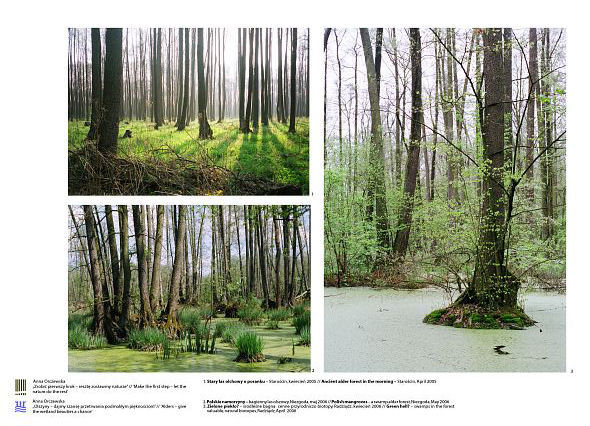
Description popularizing the research project
Alder and willow groves which grow along rivers are strange places. Most of the year they are totally inaccessible as their bottom is covered with water. Only occasional tufts, each with a black alder, seem to make some stable ground. Marshy surface spreading there arouses fear not only because of mosquitoes, ticks and leeches. It is where in legends nixes had their dens and where carriages with the cruel rich disappeared in bottomless bogs. It is where will-o'-the wisps lead careless treasure hunters to their doom.
In western Europe such legends have already disappeared together with mysterious bogs. Regulated rivers do not caress riverside thickets any more. The thickets are gone too. The wetlands where alders once grew have been drained and the trees cut down. Nevertheless a lot of riverside groves have survived in Poland. The places are sanctuaries of numerous rare species characteristic for the periodically flooded areas. They are also a model to follow for a man who tries to reconstruct riverside woods in places which were once ameliorated to make room for agriculture. After decades the alders return to the meadows and fields in the river valleys. Yet they are different than the ones created by nature. No wonder as water once drained does not come back easily. So the groves probably will never became flooded again.
Observations of Silesian groves and alders which have been conducted over years show that the reconstructed woods will turn into less demanding stands with much drier soil. The conditions of alders survival are met only in places where wild rivers flow. There are not too many places like that in Europe, but we still have them in Silesia. They are an underestimated asset which is not only a training ground for researchers from the whole European Union but an attraction for tourists crowding in survival camps. There in the abundance of wild life you will hear ominous splashes. It may be a nix or a sign that water so tightly connected with the woods is in its right place.
Abstract
As a consequence of amelioration (drainage) wetland ecosystems, including forests with Alnus glutinosa as a main component of a stand, have almost entirely disappeared from the landscape of western Europe. That process has contributed to a decrease in the abundance of plant indicators of moist and wet soils, or even to their extinction. However, alder carrs, and riveside carrs where alders play a dominant role in the tree layer, are still common in forested areas in Poland. The large species richness and diversity of such forests can be used as a reservoir of rare plants for the colonisation of recent alder woods planted on the abandoned meadows and fields which are located in their proximity.
The aim of the research was to compare soil and hydrological conditions in alder forests of different management history, that is ancient forests and alder woods planted on post-agricultural sites. Basing on the recorded data about the chemical properties of the soils and about water regime, an attempt was made to predict the possible direction of secondary succession in recent woodlands (either leading to riverside carrs, alder carrs, or oak-hornbeam communities).
Alder forests predominantly occur on fertile, eutrophic soils, and hydrological conditions play the essential role in their development. Forests of such a character may only persist in natural conditions, with a stable pattern of water regime. Any changes in their hydrological conditions, mainly due to human impact (amelioration), initiate a process of transformation of alder carrs into riverside carrs and oak-hornbeam communities.
The results of the investigations indicate that in most cases recent alder woods have been planted on gleysols, which represent soils which have been formed as a result of water level changes caused by drainage. They posses a stagnant-rewashing type of water management. According to the typology of forest habitats recent alder woods studied represent alder carrs, ash carrs or damp forests. The studies on the soil conditions have shown that that many chemical properties of the soils of the forests compared differ significantly. Some of them have a strong influence on the character of the herb layer composition in recent woods, whereas others play an essential role in the floristic composition of the herb layer of ancient forests.
A former agricultural use of soils of the recent, black alder plantations lead to the long-lasting changes in the soil conditions of these woods. Thus, a management history of the sites has a great influence on the formation of the herb layer composition in forests.
In the case of some study sites water conditions which were recorded during the course of the research allow for an assumption that alder woods will not persist there in the future. Many post-agricultural recent alder woods are only at a transitional stage of woodland development, resulting in woods with drier soils and a different species composition.

